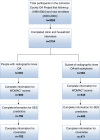Independent associations of socioeconomic factors with disability and pain in adults with knee osteoarthritis
- PMID: 24134116
- PMCID: PMC3906978
- DOI: 10.1186/1471-2474-14-297
Independent associations of socioeconomic factors with disability and pain in adults with knee osteoarthritis
Abstract
Background: The purpose of this study is to explore the relationship between function, pain and stiffness outcomes with individual and community socioeconomic status (SES) measures among individuals with radiographic knee osteoarthritis (rOA).
Methods: Cross-sectional data from the Johnston County Osteoarthritis Project were analyzed for adults age 45 and older with knee rOA (n = 782) and a subset with both radiographic and symptomatic knee OA (n = 471). Function, pain and stiffness were measured using the Western Ontario and McMasters Universities Index of Osteoarthritis (WOMAC). Individual SES measures included educational attainment (<12 years, ≥12 years) and occupation type (managerial, non-managerial), while community SES was measured using Census block group poverty rate (<12%, 12-25%, ≥25%). SES measures were individually and simultaneously examined in linear regression models adjusting for age, gender, race, body mass index (BMI), occupational physical activity score (PAS), comorbidity count, and presence of hip symptoms.
Results: In analyses among all individuals with rOA, models which included individual SES measures were observed to show that occupation was significantly associated with WOMAC Function (β =2.91, 95% Confidence Interval (CI) = 0.68-5.14), WOMAC Pain (β =0.93, 95% CI = 0.26-1.59) and WOMAC Total scores (β =4.05, 95% CI = 1.04-7.05), and education was significantly associated with WOMAC Function (β =3.57, 95% CI = 1.25-5.90) and WOMAC Total (β =4.56, 95% CI = 1.41-7.70) scores. In multivariable models including all SES measures simultaneously, most associations were attenuated. However, statistically significant results for education remained between WOMAC Function (β =2.83, 95% CI = 0.38-5.28) and WOMAC Total (β =3.48, 95% CI = 0.18-6.78), as well as for the association between occupation and WOMAC Pain (β =0.78, 95% CI = 0.08-1.48). In rOA subgroup analyses restricted to those with symptoms, we observed a significant increase in WOMAC Pain (β =1.36, 95% CI = 0.07-2.66) among individuals living in a block group with poverty rates greater than 25%, an association that remained when all SES measures were considered simultaneously (β =1.35, 95% CI = 0.06-2.64).
Conclusions: Lower individual and community SES are both associated with worse function and pain among adults with knee rOA.
Figures
Comment in
-
The rate of joint replacement in osteoarthritis depends on the patient's socioeconomic status.Acta Orthop. 2016 Jun;87(3):245-51. doi: 10.3109/17453674.2016.1161451. Epub 2016 Mar 16. Acta Orthop. 2016. PMID: 26982799 Free PMC article.
References
-
- Centers for Disease C, Prevention. Prevalence and most common causes of disability among adults--United States, 2005. MMWR Morb Mortal Wkly Rep. 2009;14(16):421–426. - PubMed
-
- Centers for Disease C, Prevention. Prevalence of doctor-diagnosed arthritis and arthritis-attributable activity limitation --- United States, 2007-2009. MMWR Morb Mortal Wkly Rep. 2010;14(39):1261–1265. - PubMed
Publication types
MeSH terms
Grants and funding
LinkOut - more resources
Full Text Sources
Other Literature Sources


